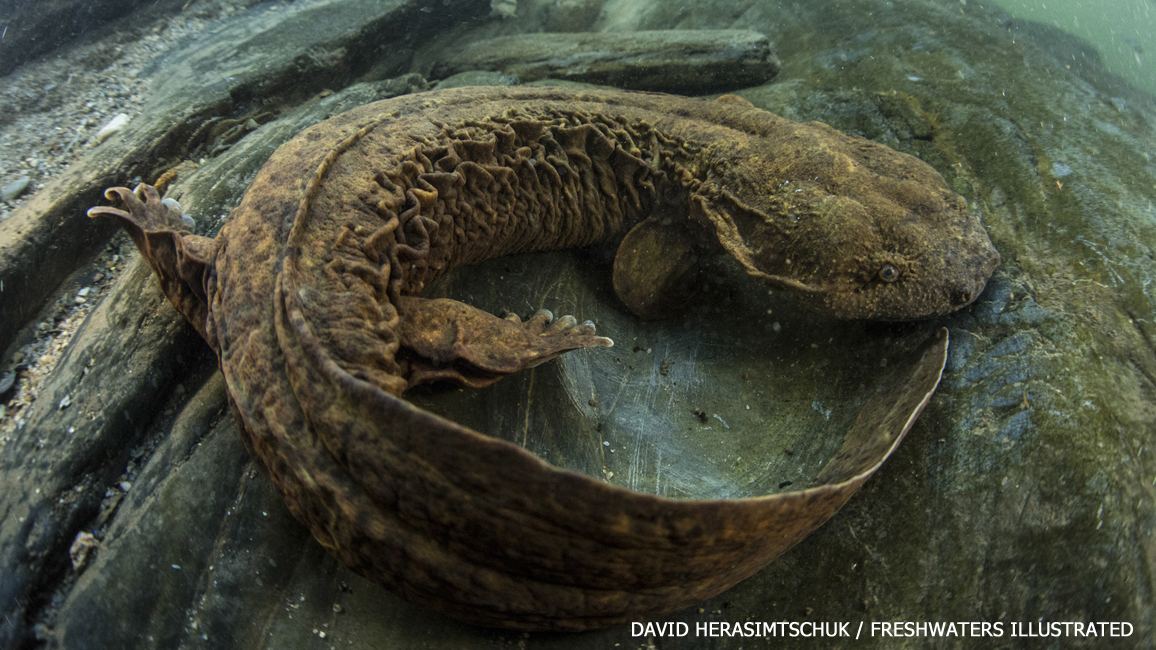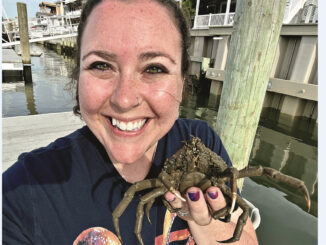
Hellbenders
By Kathy Kranking; photos by David Herasimtschuk/Freshwaters IllustratedHellbender? Snot otter? Lasagna lizard? This secretive salamander goes by lots of different names. But many people have never even heard of it.

In certain cold, clear rivers of the central and eastern United States (see map above), fishes swim, turtles crawl, crayfish skitter, and snakes slither. But another, much rarer, kind of creature might live there, too.
Hiding under flat rocks during the day, an eastern hellbender keeps a low profile. Even though hellbenders can grow to be as long as your arm, most people who live near them have never even seen one. But there’s a lot to discover about this slimy salamander!

SLIME TIME
Yup, that’s right—slimy! A hellbender can ooze gooey slime from its skin. That’s probably how it got the “snot” part of the name “snot otter.” But it’s definitely not an otter!
A hellbender’s slime may keep the salamander from being scratched by rough rocks. It also makes its body super slippery! That helps protect the hellbender from raccoons, minks, otters, or other enemies that might try to grab it. An enemy that does manage to catch a hellbender might be sorry, though. The slime tastes really gross and can make the enemy spit the hellbender right back out. Better to find something else to eat!
CRUNCH AND MUNCH
Speaking of eating, you might wonder what a hellbender has on its menu. Well, its favorite things to eat are crayfish and fishes. But hellbenders will sometimes eat other things, such as tadpoles, snakes, and even other hellbenders!
BREATHING EASY
Though a hellbender can leave the water, most of the time it doesn’t. It can move much faster in the water than on land, so it’s safer from predators in the water. And it has a special trick for breathing underwater: It breathes through its skin! A hellbender’s skin has lots of wrinkles, giving it more skin surface to breathe through. That wrinkly skin may be how the hellbender got another of its strange names: “lasagna lizard.” The skin looks a little like rippled lasagna noodles! (But, of course, it’s not a lizard.)

VIDEO: WATCH HELLBENDERS IN ACTION!
MR. MOM
Hellbenders use rocky hideouts for more than just places to rest during the day. They also use them as nesting spots for their eggs.
During mating season, males often fight over the best rocks to nest under. Once a male has won his spot, he’ll dig a hole under it, then wait for an interested female to come along. The female will lay anywhere from 200 to 500 eggs in the nest. Then the male fertilizes the eggs with his sperm. After that, the female leaves, and the male is in charge.
For the next few months, the dad hellbender guards the eggs. (But sometimes he may get hungry enough to eat a few.) Once the eggs hatch, the hundreds of baby salamanders, called larvas, will soon swim off on their own.
TROUBLES FOR HELLBENDERS
Even if a larva survives to become an adult, a hellbender faces a lot of challenges. These animals have disappeared from many rivers and streams where they once lived. Many die from disease. But the biggest problem for hellbenders is that their streams are being ruined. Chemicals from farming and mining pollute their streams,making it hard for them to breathe. And people clear away trees to build buildings and make farms, causing more problems. Without tree roots to hold the ground in place, rain washes soil into the hellbenders’ streams. This clouds up the water, fills in the spaces under rocks, and buries hellbender eggs.
But there’s some good news. Scientists have been breeding hellbenders in zoos. They’ve also been collecting hellbender eggs from the wild and raising the young. In both cases, when the hellbenders are about 3 years old and almost 10 inches long, the scientists release them in places with the clearest, healthiest water. With help from people, these slimy salamanders may be able to slide safely into the future.
















